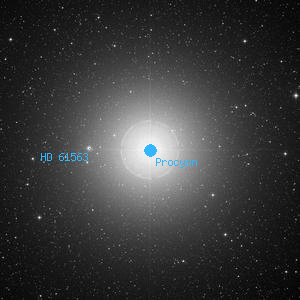Procyon

Overlaid DSS image of Procyon, 60' x 60' with north at top and west to the right
Aladin viewer for the region around Procyon
Puana, Alpha Canis Minoris, α CMi, 10 CMi
BD+05 1739, HD 61421, HR 2943, WDS J07393+0514, SAO 115756, HIP 37279
BD+05 1739, HD 61421, HR 2943, WDS J07393+0514, SAO 115756, HIP 37279
| Type | Star |
|---|---|
| Magnitude | 0.37 | Right Ascension | 7h 39' 18.2" (2000) |
| Declination | 5° 13' 30" N |
| Constellation | Canis Minor |
| Description | Dist. 11.402 ly |
| Classification | F5IV-V+DQZ |
Observing Notes
Andrew Cooper
Feb 27, 2020 Waikoloa, HI (map)
20cm f/6 Newtonian, Cave Astrola @ 61x
Seeing: 6 Transparency: 7 Moon: 19%
Brilliant white with a tinge of yellow, no companion noted
Captain William Henry Smyth
Oct 23, 1833 No. 6 The Crescent, Bedford, England (map)
150mm f/17.6 refractor by Tully 1827
A standard Greenwich star with a distant companion, on the loins of the Lesser Dog. A 1½, yellowish white; B 8, orange tinge; several small stars in the field. A is a splendid star, though very considerably less bright than Sirius, which accounts for the latter being called the Greater Dog, quite as well as the assigned reason, as to rising time. Authorities have differed as to Procyon's magnitude; Ptolemy and Hevelius designating it 1, Tycho Brahe 2, and most of the others 1½. Hunters after parallax will recollect, that this is one of those stars upon which Piazzi bestowed such labour to detect the angle which the mean diameter of the Earth's orbit subtends from them, as related in the XIIth volume of the Italian Society's Memoirs; and that an infinity of observations induced him to assign 3"± as the value of Procyon [Hipparcos 284.56mas]. It has also a large proper motion in space; it is variously assigned; but the following values are the most coincident:
P.... RA -0".71 Dec. -0".98
B.... -0".63 -1".05
A.... -0".69 -1".05
[Hipparcos -0".71459 -1".03680]
Canis Minor, though a small asterism, is one of the old 48, and, as well as its lucida, was called Προκυων, the precursor-dog, because it appeared in the morning dawn before Sirius: though Jacob Bryant persists that the Greek filched the word from the Egyptian Pur Cahen. Hence also its name of Ante-Canis; and it was popularly considered as Orion's second hand, or Canicula, which title Horace, Pliny, Hyginus, and Galen, support against Germanicus, Julius Firmicus, and Appian, who are all for Sirius. The Arabians recognised its quality of forerunner to the Dog-star in al-kelb-al-mutekaddem, the antecedent dog; but they also called it Al-shi'ra-l-shámiyah, the bright star of Syria; ghomaïsá, watery-eyed; and Al-kelb-al-asghar, the lesser dog. All this shows that the constellation was one of much interest, and the regard of the ancients descended to the astrologers of later ages: "What meteoroscoper," demands old Leonard Digges, " what meteoroscoper, yea, who learned in matters astronomical, noteth not the great effects at the rising of the starre called the Litel Dogge?"
This constellation stands to the north-east of the Greater Dog, so that the Milky Way passes between them; and under Gemini. They were anciently in closer connection, but the intrusion of Monoceros between them, by Hevelius, has parted them. The number of stars given to this asterism, in successive Catalogues, has been as follows:Ptolemy . . . . 2 stars Bayer . . . . . 8 starsProcyon is a member of the magnificent equilateral triangle formed in conjunction with Sirius and Betelgeuze, as well as a right-angled one with Betelgeuze and Pollux. A perpendicular raised at Sirius to a line drawn from that star to Orion's belt, will also pass through Procyon to the northward; or, as the alignment is expressed:
Hyginus . . . . 3 Hevelius . . . . 13
Tycho Brahe* . . . 5 Flamsteed . . . 14
Kepler . . . . . 5 Bode . . . . . 55Orion's belt from Taurus' eye, leads down to Sirius bright,
His spreading shoulders guide you east, 'bove Procyon's pleasing light.― A Cycle of Celestial Objects Vol II, The Bedford Catalogue, William Henry Smyth, 1844
Other Data Sources for Procyon
Nearby objects for Procyon
7 objects found within 120'
| Delta2 Canis Minoris | Delta3 Canis Minoris | HD 60803 |
| HD 61563 | HD 61887 | UGC 3912 |
| UGC 3946 |
Credits...
Drawings, descriptions, and CCD photos are copyright Andrew Cooper unless otherwise noted, no usage without permission.
A complete list of credits and sources can be found on the about page
Procyon